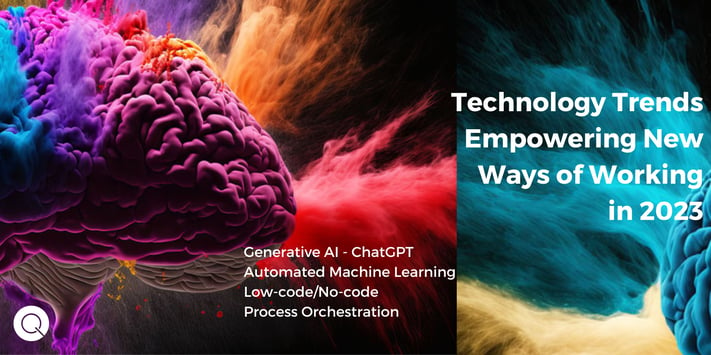
This time three years ago, who would have predicted the changes in intelligent automation – not to mention the world as a whole – we will see in the coming months and years.
Back then we were talking about the democratisation of automation. Roll on three years and the pandemic’s acceleration of digital transformation has changed the IT landscape dramatically.
So where to next?
If I had to sum up one driving force behind all the trends we see for this year, it’s simple: How to do more with less.
Customer expectations are rising and good enough is no longer good enough. Businesses continue to face workforce shortages, economic headwinds and inflationary challenges. These conditions have placed more focus on how technology can be used to bring real business benefits – increasing productivity, agility and innovation and helping address skills shortages.
The pandemic pushed many companies to begin laying the foundations for a digital future. Now is the time to start building on those foundations to build businesses to power ANZ – and its people – into the future.
Here at Quanton, we see four key trends shaping the New Zealand and Australian market in 2023.
1. Generative AI for personal automation and productivity
Generative AI will be one of the biggest AI trends of 2023 and start to disrupt many industries moving forward. Its ease of use, ability to be rapidly integrated, high value and low cost will be pivotal in driving its adoption in New Zealand and Australia. Businesses that are agile and forward looking will seize the opportunity provided.
Generative AI is a technology that has been trained on a huge dataset of existing text, audio files and images to create new content, and has been around for a while now. From Microsoft’s auto-prompts, to using OpenAI’s DALL-E deep learning model where I can create an image just by typing natural language requests such as ‘an armchair in the shape of an avocado’.
OpenAI’s ChatGPT is gaining a lot of interest and is a conversational language that model uses deep learning to generate human-like text, making it capable of understanding and responding to a wide range of topics and questions.
ChatGPT and other language models like it have the potential to be highly disruptive in a number of industries.
- In customer service, chatbots and virtual assistants powered by language models can automate many routine tasks and help companies provide 24/7 service at a lower cost. This can lead to increased efficiency and customer satisfaction.
- In the field of content creation, they can be used to generate written content, such as news articles, product descriptions, and even creative writing. This has the potential to revolutionise the way content is produced, making it faster and less expensive to create high-quality content.
The potential uses of such language models are still being explored and developed, but it is clear that they have the potential to change many industries and the way we interact with technology.
Imagine if anyone in your company could create their own personal automation just by typing in their requirement, generating a ‘skeleton’ automation with the required activities.
It could be as simple as an automation to save Excel attachments in Outlook emails from a particular person to a particular location. Or it could be more complex such as helping businesses with predictive maintenance, improving cybersecurity analytics or generating new ideas for solutions.
GitHub’s Copilot, powered by OpenAI Codex, has shown how the dreams of using AI for coding truly are within reach now. While creating entire software applications using natural language might still be years away, targeted use cases are not only within reach, but already being achieved today.
2. Automated machine learning with feedback loops to democratise AI
Machine learning is still largely the domain of skilled data scientists. But what if you could develop an optimal machine learning model without extensive data science knowledge and use human involvement for exceptions only, with the AI learning from those humans?
What if you could bring AI closer to the people who know your customers the best – your employees – through automated machine learning with rapid feedback loops?
That’s the promise of automated ML. It removes the need for scarce data scientists to design Machine Learning models and fine tune the performance of different algorithms. This offers the potential to reduce the time and cost, enabling quicker time to market.
Automated ML with feedback loops – which are key to improving the performance of models – allows model more frequent model retraining and validation in real time to ensure the predictive model is up-to-date.
3. Low-code/no-code to power up innovation – democratising access to automation and AI to drive business value AI
We’ve been talking about it for more than a year now and Gartner has forecast that by 2025, 70 percent of new apps developed by enterprises will use low-code/no-code technologies.
Imagine if everyone in your business was capable of building customer-centric applications to address your customer’s and business needs.
Your business would take a quantum leap in agility and responsiveness, be more attuned and aligned with its customers and able to respond rapidly to the market ahead of your competitors to get new innovations to market that much faster.
4. Process orchestration workflow for productivity at scale
We’ve known for the longest time that organisations are struggling to deliver productivity at scale when it comes to operational improvement or automation.
Process orchestration workflow, orchestrating end-to-end workflows across your business, drives value across end-to-end customer journeys enabling efficient use of both human’s and bots.
It’s an opportunity to manage workflows and orchestration of work across a hybrid workforce and ensure the right work gets to the right human – or bot – on time.
The automation layer connects people, processes, systems and internal and external data, eliminating fragmented processing and data silos to provide a unified view of operations. And with that end-to-end visibility of your processes, you gain a clear understanding of the bottlenecks within a process – and with it an opportunity for continuous improvement!
In our experience, organisations using process orchestration have typically seen increases in operational efficiency of up to 20 percent.
There’s another ‘trend’ that we’re even more excited about, and that’s the increasing move of automation and disruptive technologies into New Zealand’s mid-market businesses. They see the benefits and can act quicker than big enterprises.
Although we have significant economic and business challenges, the smart utilisation of these technologies can give businesses a significant competitive advantage in 2023 and beyond – and that’s something we’re happy to applaud!

